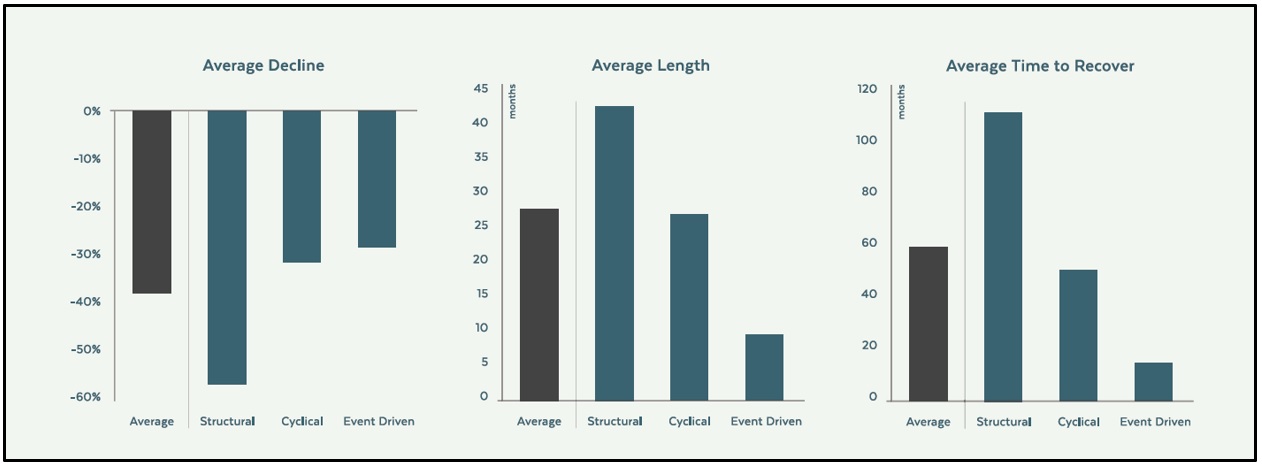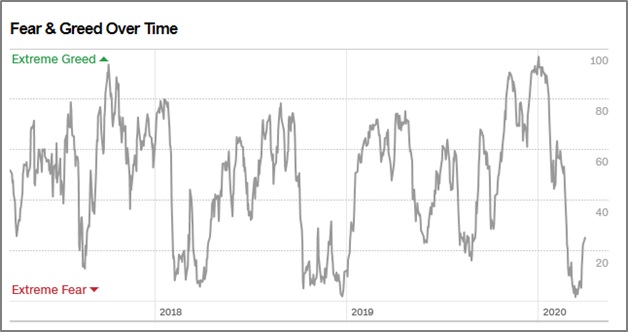Stay Agile Investing In The Ides Of March
Submitted by Silverlight Asset Management, LLC on March 31st, 2020
“Beware the Ides of March,” a soothsayer told Julius Caesar in Shakespeare’s famous play of the same name.
Whether you believe in superstitions or not, March of 2020 will go down as a historic month on Wall Street. After peaking on February 19th, the S&P 500 fell 34% in just 23 trading days, marking the fastest bear market ever.
Stocks have since rallied back. But the overall surge in volatility has been breathtaking. For perspective, the S&P’s average daily move this month was 5.14%, which easily tops the previous record of 3.90% (November 1929).
Many are now opining on whether it will be an L, U or a V-shaped recovery.
Truth is, nobody knows what comes next. There is no way to backtest for a global pandemic in the modern era.
THIS is the test. We’re living it.
Thus, if you’re an active investor, now is a time to stay agile in your thinking.
Stay Agile Revisiting Your Asset Allocation
Sometimes events come along that teach us what our true risk tolerance is. COVID-19 has shaken up daily life and many portfolios. If you lack confidence in your current strategy, what should you do?
My advice would be to revisit your financial goals, starting with two questions.
- Is your financial plan still on track?
- What is the required return to fund your goals?
Bear markets are scary, but also totally normal. A bear market should not derail a well constructed financial plan. You can sanity check yours by having your financial advisor run monte carlo simulations based on current values.
Even if your retirement plan is “on track,” you may still want to lower volatility. And that may be totally fine, but it depends on your situation.
Hypothetically, let’s assume the 5-year annualized return from a traditional 70/30 portfolio (70% stocks, 30% bonds) is 8%. For a 50/50 portfolio, the expected return is 6%.
Based on the laws of compounding, that 2% difference will turn into a meaningful spread over time. But if someone doesn’t need the extra return, they don’t need any extra headaches. It might make sense to focus on reducing tail-risk.
Stay Agile Following Fundamentals
COVID-19 and the corresponding shuttering of businesses will exert a heavy toll on the near-term economic outlook.
Goldman Sachs GS forecasts a 34% GDP contraction in Q2 and sees the unemployment rate jumping to 15%. Meanwhile, consensus expects earnings-per-share for the S&P 500 to fall 10% in Q2, and that number will likely drift lower.
The magnitude of the economic slowdown won’t ultimately be as pivotal as the duration. Many firms can handle a few months of business disruption, but not much more. The speed of normalization is the key factor.
For now, Goldman projects a swift rebound. The investment bank forecasts GDP to rise 19% in Q3, aided by fiscal and monetary stimulus.
Policy Response. It’s easy to anchor to today’s negative headlines, but don’t dismiss the magnitude of recent stimulus measures. Here’s a quick summary.
Fiscal Stimulus
- Total spending so far is around $2 trillion, which equates to 9.5% of GDP
- Most will be paid out in 2020
- Required Minimum Distributions (RMDs) are optional for 2020
- Early 401(k) withdrawals are permitted in certain cases
- Many households will soon receive ‘helicopter money’ via checks in the mail
- $500 billion in loans and business assistance programs for big companies
- Small businesses will have access to a separate $350 billion facility
Monetary Stimulus
- Unlimited QE program
- New facility to buy investment grade corporate bonds and bond ETFs
- Relaxing bank capital rules to encourage more lending
- Extra liquidity to aid money markets, commercial paper and muni debt
Valuations. Bonds have enjoyed a spectacular 40-year bull market, but yields simply can’t go much lower. The max upside from here on a 10-year treasury bond before the zero boundary is roughly 7%.
Equities offer better value. Per Bloomberg, the cyclically adjusted earnings yield for the S&P 500 is 4.8%. The earnings yield of the MSCI World ex USA Index is 6.5%, making international stocks an even better bargain.
Bear markets are a great time to tactically shift country exposure. For more on why that is the case, you can read this article: 2 Major Investment Cycles Are Nearing Peaks, Here’s How To Prepare.
Stay Agile Monitoring Technical Levels
Since 1929, the average bear market has declined -39% and lasted about 2 years. However, that doesn’t automatically imply a long, arduous bear market lies ahead.
Every bear market is different, with most falling into one of three categories.
- Structural bear markets are triggered by structural imbalances and financial bubbles, often resulting in price shocks and deflation.
- Cyclical bear markets are part of a normal business cycle and typically commence during periods of high inflation and rising interest rates.
- Event-driven bear markets can be triggered by policy mistakes or any sudden shock. They typically lead to a sharp market decline but not a long recession.
So far, this is an ‘event-driven’ bear. Historically, these bear markets are shorter, less severe, and take less time to recover than structural or cyclical bear markets.

Source: Hyde & Union Content, Goldman Sachs Global Investment Research
While we can take some comfort in the above, we still need to monitor incoming data.
The “Coronavirus Crash” has been fast and ferocious. A lot to absorb.
The novel coronavirus is also one of the most discounted events ever.
Think about it: COVID-19 is literally everywhere. It’s all anybody talks about. It dominates the media. We’re even reminded of it driving on the highway.
Scary signs, dire headlines and dismal price action have depressed investor sentiment.
But when extreme fear gets priced into the market, it’s usually a buy signal.

Source: CNN
Of course, we don’t know yet if the recent market low is the bottom. That will largely depend on whether this economic shock morphs into a stickier, structural problem.
One encouraging sign is a flurry of insider buying. C-suite executives only buy in the open market when they think their stock is undervalued and will go up. The ratio of companies with insider buying compared to insider selling was 1.75 for March, the highest level since March of 2009.
If you incorporate technical analysis into your decision-making, use trend exhaustion signals. They are the best tactical guide for a climate like this, where the greatest risk is getting whipsawed. Don’t get whipsawed.
One tool that is excellent at spotting potential trend inflections is called TD Combo. It’s popular with hedge funds and institutional investors. Early last week, there was a TD Combo 13 buy signal for the MSCI All Country World Index (ACWI).

Source: Bloomberg, DeMark Analytics
***
A key takeaway from the Ides of March was to expect the unexpected. Going forward, we should all try to heed that lesson.
For instance, I’m more bullish now than at the start of the year. But I’m also taking it one day at a time, keeping an open mind.
Embrace uncertainty.
Originally published by Forbes. Reprinted with permission.
This material is not intended to be relied upon as a forecast, research or investment advice. The opinions expressed are as of the date indicated and may change as subsequent conditions vary. The information and opinions contained in this post are derived from proprietary and nonproprietary sources deemed by Silverlight Asset Management LLC to be reliable, are not necessarily all-inclusive and are not guaranteed as to accuracy. As such, no warranty of accuracy or reliability is given and no responsibility arising in any other way for errors and omissions (including responsibility to any person by reason of negligence) is accepted by Silverlight Asset Management LLC, its officers, employees or agents. This post may contain “forward-looking” information that is not purely historical in nature. Such information may include, among other things, projections and forecasts. There is no guarantee that any of these views will come to pass. Reliance upon information in this post is at the sole discretion of the reader.
Testimonials Content Block
More Than an Investment Manager—A Trusted Guide to Financial Growth
"I’ve had the great pleasure of having Michael as my investment manager for the past several years. In fact, he is way more than that. He is a trusted guide who coaches his clients to look first at life’s bigger picture and then align their financial decisions to support where they want to go. Michael and his firm take a unique and personal coaching approach that has really resonated for me and helped me to reflect upon my core values and aspirations throughout my investment journey.
Michael’s focus on guiding the "why" behind my financial decisions has been invaluable to me in helping to create a meaningful strategy that has supported both my short-term goals and my long-term dreams. He listens deeply, responds thoughtfully, and engages in a way that has made my investment decisions intentional and personally empowering. With Michael, it’s not just about numbers—it’s about crafting a story of financial growth that has truly supports the life I want to live."
-Karen W.
Beyond financial guidance!
"As a long-term client of Silverlight, I’ve experienced not only market-beating returns but also invaluable coaching and support. Their guidance goes beyond finances—helping me grow, make smarter decisions, and build a life I truly love. Silverlight isn’t just about wealth management; they’re invested in helping me secure my success & future legacy!"
-Chris B.
All You Need Know to Win
“You likely can’t run a four-minute mile but Michael’s new book parses all you need know to win the workaday retirement race. Readable, authoritative, and thorough, you’ll want to spend a lot more than four minutes with it.”
-Ken Fisher
Founder, Executive Chairman and Co-CIO, Fisher Investments
New York Times Bestselling Author and Global Columnist.
Packed with Investment Wisdom
“The sooner you embark on The Four-Minute Retirement Plan, the sooner you’ll start heading in the right direction. This fun, practical, and thoughtful book is packed with investment wisdom; investors of all ages should read it now.”
-Joel Greenblatt
Managing Principal, Gotham Asset Management;
New York Times bestselling author, The Little Book That Beats the Market
Great Full Cycle Investing
“In order to preserve and protect your pile of hard-earned capital, you need to be coached by pros like Michael. He has both the experience and performance in The Game to prove it. This is a great Full Cycle Investing #process book!”
-Keith McCullough
Chief Executive Officer, Hedgeye Risk Management
Author, Diary of a Hedge Fund Manager
Clear Guidance...Essential Reading
“The Four-Minute Retirement Plan masterfully distills the wisdom and experience Michael acquired through years of highly successful wealth management into a concise and actionable plan that can be implemented by everyone. With its clear guidance, hands-on approach, and empowering message, this book is essential reading for anyone who wants to take control of their finances and secure a prosperous future.”
-Vincent Deluard
Director of Global Macro Strategy, StoneX


